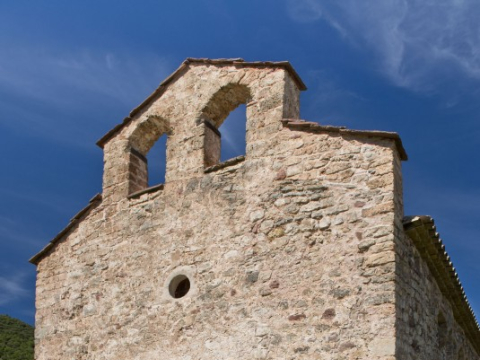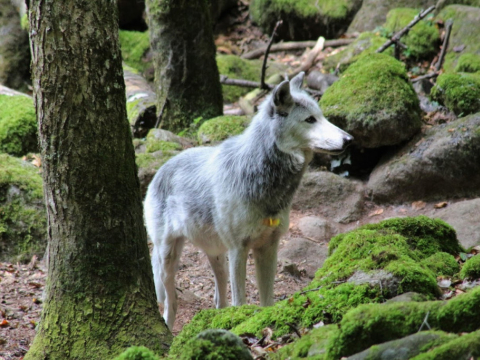This pass is the watershed between the Llobregat and Segre basins. On the eastern slope, the torrent of Les Molleres flows down, which goes, through the Saldes area, towards the Llobregat. The Cerneres River flows along the western slope of the pass, which drains into the Josa River, and further down the Vansa, a tributary of the Segre. The view from the pass is privileged, especially over the Pollegó Superior del Pedraforca.
Located on a strategic rocky hill that dominates the Esponne valley, absolutely unattackable on three sides -only vulnerable on the northwest-, it is a castle that dates back to 1034, where Catharism was absolutely rooted. From that moment until the Crusade, it was owned by the Lords of Pailhés (who were at all times on the side of the Count of Toulouse and Foix). In 1273, after the imprisonment of the Count of Foix, the castle passed into the hands of the crown. In the 17th century, Richelieu ordered...
The Merenç horse or the “black prince” is the symbol of Ariège. It is a noble, handsome, calm, shy, brave, docile and resistant pony to the inclemencies of the climate and terrain. A good collaborator in former times for farmers, street vendors and smugglers, it is now ideal for mountain routes of some difficulty. High mountain specimens can still be found grazing in their natural habitat. Despite being on the verge of disappearing, they are now experiencing a moment of clear expansion and...
A large house with ruins, it also has a church dedicated to Sant Martí del Puig which is still preserved.
Chestnut forests near Montferrier.
12th century hermitage.
This pond could have been formed by a landslide of mountain rocks, which cut off the course of the river and acted as a natural dam, retaining the water. The pond, due to its geological characteristics, is shallow and depends on water flows.
Old farm house in ruins located at the foot of the Gran de Ferrús rock and from where you can almost completely dominate the valley. The house is currently used to house livestock.
In the course of the Cardener River, right below the church of La Pedra, with pure and medicinal waters and known for its healing benefits.
-
It belongs to the Vansa i Fórnols town council; it is a small village sheltered around the church of Sant Climent, a building rebuilt in modern times although it retains one of the Romanesque walls.
A modern copy of a Romanesque image and a fragment of a Gothic altarpiece dedicated to Sant Climent are preserved. In the village there is the Baroque Roser Chapel, and not far away, the remains of the old Fórnols Castle. They are made up of a vast rocky and karst complex, with an impressive difference in altitude. Numerous remarkable species inhabit it, subject to national protection measures. Among the vegetation we can find the majestic flowers of the yellow marcòlic and rock plants.
It is a very special place for bird lovers, where they can observe the golden eagle, the eagle owl and the Pyrenean owl.This population is repeatedly alluded to in documents and acts of inquisitorial processes against Catharism. In 1250 Gósol appears in several attestations in the episcopal archive of La Seu d'Urgell as a "place of Cathars", a "heretical" focus, a true Cathar enclave related to Josa and Castellbò but also to Tarascon d'Ariège and other places in Occitania. In 1256, Galceran de Pinós was forced to intercede with the archbishopric of Tarragona on behalf of some of his vassals from Gósol accused...
A small inhabited village, the church dedicated to Sant Andreu de Gréixer stands out.
In the middle of the valley there is a mass of large rocks. If you go up to take a look, you can see that the river here makes a horsetail-style waterfall.
-
An animal park dedicated entirely to the wild spirit of the wolf. Located in the heart of the Orlu National Game and Wildlife Reserve, our park offers you a total immersion in the fascinating world of these legendary predators. Explore our vast spaces, home to a variety of packs, from majestic European wolves to brave Canadian wolves, magnificent Arctic wolves and many more.
A beautiful puddle of meltwater that can be seen from afar and stands out because it is almost round. The lake was formed because fallen rocks closed the valley and acted as a natural dam. Like all high mountain lakes, seen up close it has very clean and transparent water, but the general view of the lake shows it to be black and cold. In its surroundings, conifers begin to appear among the incredible amount of granite rocks that flood this environment.
Travelers traveling between the Ariège and Querol valleys had to cross the Pimorent pass, where weather conditions, especially in winter, made the passage difficult. It is for this reason that during the second half of the 15th century, the French King Louis XI ordered the construction of a hospitality facility, where travelers could take refuge and receive the necessary attention before continuing on their way. Several houses were grouped around the Ospitalet near Andorra, which over time gave...
An old, narrow stone bridge over the Ariège River stands out. Past the bridge is the road and the entrance to the town with the town hall (mairie), the church, etc. Restaurants and shops are clustered along the road.


